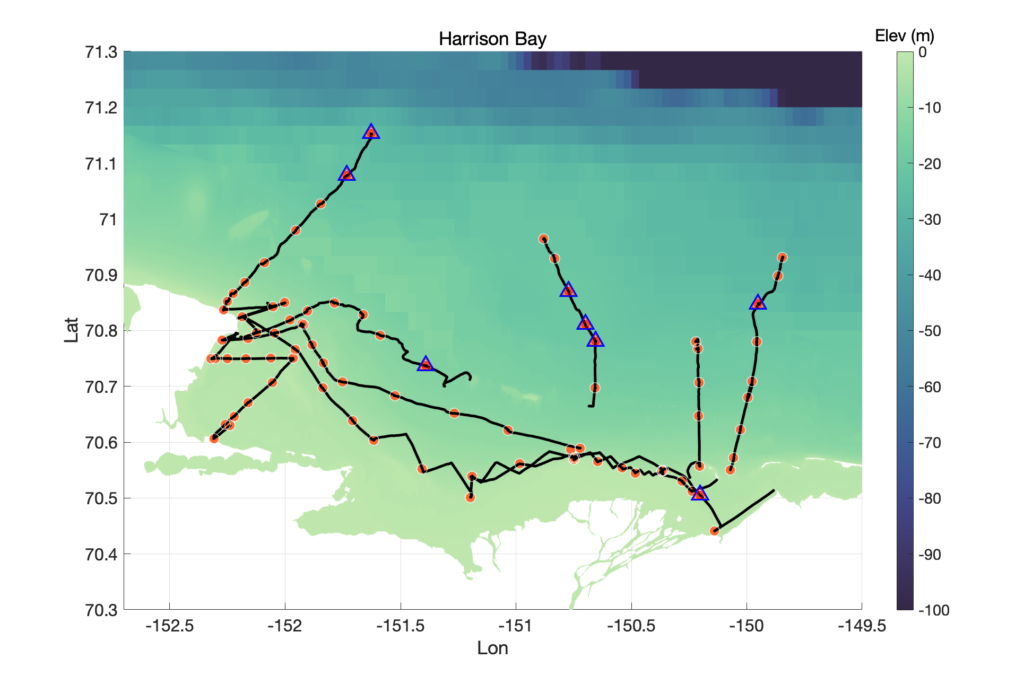Some of the highest rates of coastal erosion worldwide occur in the Arctic where permafrost-rich bluffs meet the ocean. Current research across the Arctic leverages satellite images, drones, lidar, and ground-based surveys to quantify and inform models of shoreline erosion processes and retreat rates—but little is known about the fate of sediments released from eroding arctic bluffs after they enter the coastal ocean. In temperate systems, waves and currents serve to transport sediments along and across the continental shelf. In the Arctic, these processes are complicated by seasonal sea ice cover (for up to nine months per year).

In this project, we are investigating the how, when, where, and why of arctic coastal sediment transport and deposition across continental shelves. Key research questions include:
- What seabed sediment textures and properties are found on arctic continental shelves, and do they correspond to known zones of ice impact (e.g., the stamukhi zone)?
- What are the dominant processes which facilitate sediment transport (fairweather waves, swell, tidal currents, wind-driven currents)? Are these processes able to drive sediment from the nearshore to the middle shelf in a single season?
- How do these processes impact the morphologic evolution of the continental shelf and nearby coastal landforms like the Colville Delta?
- Where are dominant sites of deposition on arctic shelves? How well can these be determined given the nature of ice keel scouring in the winter?

This work is timely because arctic sea states are increasing, meaning that more wave energy is available to mobilized sediments in the present than in the past. Sediments can carry nutrients and also pollutants, and understanding how they are re-distributed in the ocean — and how those rates of transport are changing — is important to managing arctic environmental systems and protecting infrastructure.
This work is a collaborative effort between coastal oceanographers, sedimentologists, coastal modelers, and geotechnical engineers:
| Dr. Emily Eidam | OSU/UNC | Project lead |
| John Malito | UNC (now TX BEG) | MS student (degree 2022) |
| Caroline Cooper | UNC | MS student (present) |
| Adrian Heath | OSU | MS student (present) |
| Dr. Jaap Nienhuis | University of Utrecht | co-PI |
| Dr. Nina Stark | Virginia Tech | co-PI |
| Nick Brilli | Virginia Tech | PhD candidate (present) |
| Dr. Jeff Obelcz | NRL | Participant |
| Dan Duncan | UTIG | Research scientist |
Like many projects, this project was impacted by the pandemic, but we were extremely fortunate to have the opportunity to collaborate with Dr. Jim Thomson and the UW-APL CODA team on R/V Sikuliaq surveys in 2019 and 2020. During these trips we collected valuable baseline data about substrates and suspended-sediment dynamics near CODA project moorings at Icy Cape, Jones Island, and Flaxman Island in the Chukchi and Beaufort seas.
In 2021 and 2022, we conducted full-scale surveys for this project on the R/V Ukpik, in Harrison Bay. Measurements included:
- Vessel-based ADCP measurements
- Vessel-based CTD/Tu/PAR/LISST profiles, for water column properties and particle sizes and concentrations
- Seabed grab samples and gravity cores
- Cone penetrometer measurements (for geotechnical properties)
- Water sampling for suspended solids
- Multibeam surveys
- CHIRP surveys (2022 only)
- Small mooring deployments (~10 days in 2021, ~5 weeks in 2022)

We are excited to use these data to explore seabed textures, sediment transport dynamics, and deposit properties throughout the Harrison Bay region and Colville Delta front.










Project papers
Cooper, C., Eidam, E., Nienhuis, J. IN REVISION. Effects of sea ice on Arctic delta evolution: A modeling study on the Colville River Delta, Alaska. JGR-Oceans.
Brilli, N.C., Stark, N., Eidam, E., Nienhuis, J., Castro-Bolinaga, C. IN REVISION. Assessing Variations in Sediment Properties and Erodibility in Harrison Bay, Alaska using a Portable Free-Fall Penetrometer. Journal of Cold Regions Engineering.
Eidam, E.F., Stark, N., Nienhuis, J., Keogh, M., Obelcz, J. ACCEPTED. Subtidal Arctic Sediments. Annual Reviews of Marine Science.
Eidam, E.F., Thomson, J., Malito, J.G., Hošeková, L. (2024). Morphology and sediment dynamics of Blossom Shoals at Icy Cape, Alaska. JGR-Earth Surface, 129(4), e2023JF007398.
Malito, J., Eidam, E., & Nienhuis, J. (2022). Increasing wave energy moves Arctic continental shelves toward a new future. Journal of Geophysical Research: Oceans, 127(9), e2021JC018374.
———————————————
This project is funded by NSF grant OPP 1913195

